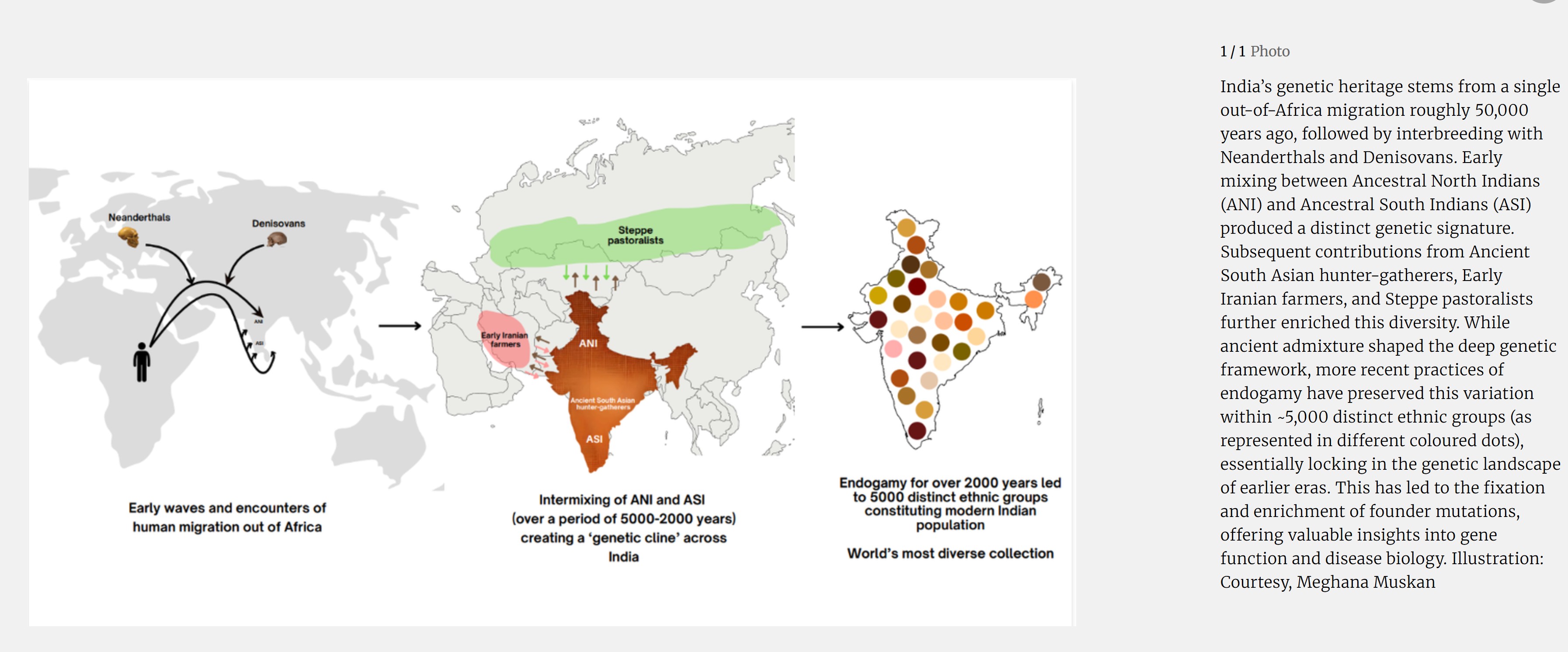India’s Unique Genetic Legacy

- 17 Aug 2025
Context:
India, with a population of over 1.4 billion and nearly 5,000 distinct ethnic groups, represents one of the richest reservoirs of human genetic diversity in the world. This diversity, shaped by ancient migrations, interbreeding with archaic humans, and centuries of endogamy, makes India a living archive of evolutionary history as well as a frontier for personalised medicine.
Evolutionary Roots and Genetic Mixing
The genetic history of Indians can be traced to a single out-of-Africa migration around 50,000 years ago. These early settlers interbred with archaic humans such as Neanderthals and Denisovans, leaving modern populations with 1–2% of archaic DNA. Some of these variants continue to influence present-day biology—for example, Denisovan genes aiding Tibetan high-altitude adaptation and Neanderthal genes linked to immune responses and even COVID-19 severity.
Within India, genetic blending between Ancestral North Indians (ANI) and Ancestral South Indians (ASI) created a distinct genetic signature. Later contributions from ancient hunter-gatherers, early Iranian farmers, and Steppe pastoralists added further complexity. This intricate demographic history is preserved in the unique genomic architecture of Indian populations, which remains poorly represented in global studies such as the UK Biobank or 1000 Genomes Project.
Endogamy and Disease Patterns
A distinctive feature of Indian society has been endogamy, or marrying within one’s community. While this preserved ancient traits, it also intensified genetic relatedness and strengthened “founder effects.” As a result, many rare recessive diseases occur at unusually high frequencies within specific groups.
For instance, the Vysya community shows a hundred-fold higher prevalence of butyrylcholinesterase deficiency, while other groups carry unique mutations linked to progressive pseudorheumatoid dysplasia or congenital disorders. Large-scale genome sequencing of ~2,700 Indians revealed that each person, on average, has at least one fourth-degree relative, underscoring the depth of relatedness. More than 1.6 lakh previously unreported variants have been identified, many linked to neurological, metabolic, and cardiovascular conditions.
Scientific and Healthcare Potential
This diversity is not merely of anthropological interest but holds transformative implications for medicine. Each Indian community functions as a natural genetic laboratory, preserving rare variants that allow scientists to study gene functions without laboratory-induced mutations. This provides an unprecedented opportunity to advance precision medicine, drug discovery, and disease prevention strategies tailored to Indian populations.
The Genome India Project, which has already sequenced 10,000 genomes, is a milestone towards this goal. Scaling it to millions of individuals, coupled with the creation of a national biobank on the lines of the UK Biobank, could position India as a global hub for genome-driven healthcare and innovation.
Challenges and Way Forward
Despite these opportunities, India faces major gaps. Representation in international genomic databases remains minimal. The risks of genetic discrimination and privacy breaches call for a robust ethical and legal framework. Moreover, integrating genetic screening into public health policy requires awareness campaigns, trained professionals, and equitable access to avoid deepening existing inequalities.
Conclusion
India’s genetic mosaic is both a scientific treasure and a public health imperative. By scaling up sequencing, building inclusive biobanks, and embedding genomics into healthcare policy, India can simultaneously improve disease management, reduce the burden of rare disorders, and emerge as a leader in global genomics research. With foresight, investment, and ethical safeguards, India’s genetic legacy can be harnessed to transform healthcare and strengthen its knowledge economy.
